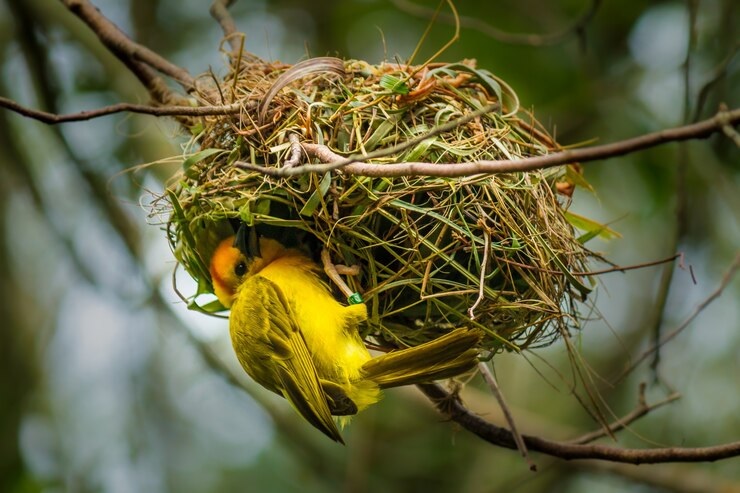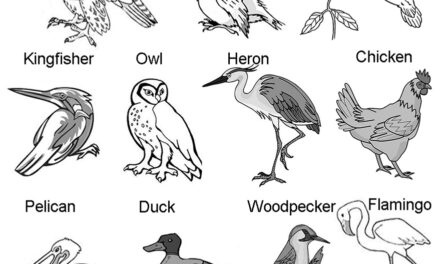Birds are not only beautiful and diverse creatures, but they also have fascinating ways of building nests and caring for their young. In this chapter, we’ll explore how different birds create their homes, with a special focus on some unique examples like the Weaver Bird, Woodpecker, Partridge, and Vulture. We’ll also learn about how birds care for their young and discover some birds known for their amazing migrations. Let’s dive in!
Why Do Birds Build Nests?
Before we look at specific birds, let’s understand why nesting is so important for birds:
– To Lay Eggs: Nests provide a safe place for birds to lay their eggs. This keeps the eggs secure from predators and helps regulate temperature.
– To Raise Chicks: Nests are essential for raising young birds. They provide a place where chicks can be fed and protected until they are ready to fly.
– To Stay Safe: Nests help birds avoid predators and harsh weather conditions. A well-built nest can be a safe haven for both eggs and chicks.
The Weaver Bird
The Weaver Bird is famous for its intricate and beautifully woven nests. These birds are skilled architects who build some of the most complex nests in the bird world.
Nesting Habits of Weaver Birds
– Nest Construction: Weaver birds build their nests by weaving together grasses, twigs, and leaves. They create large, hanging nests that can look like a bunch of woven balls.
– Materials Used: They use strong grass fibers and leaves, which they gather and then weave into a sturdy structure.
– Location: Weaver birds usually build their nests in large colonies, hanging from tree branches or reeds near water.

Weaver birds are named for their impressive weaving skills. The nests can be quite large and may house several families within one colony. The birds weave their nests in a way that helps protect them from predators.
The Woodpecker
Woodpeckers are known for their unique nesting habits and their ability to drill into trees. Their nests are built inside tree trunks or branches.
Nesting Habits of Woodpeckers
– Nest Construction: Woodpeckers create their nests by pecking holes into the wood of trees. They dig out a cavity where they lay their eggs.
– Materials Used: Woodpeckers don’t use much nesting material inside their cavities. The nest is primarily the hollowed-out space within the tree.
– Location: The nests are located inside trees, which provides protection from predators and the elements.

Woodpeckers use their strong beaks to peck at trees, creating a cavity for their nests. This unique behavior helps them find food and also serves as a nesting site. The drumming sound you often hear is actually the woodpecker tapping on trees to communicate or find insects.
The Partridge
Partridges have different nesting habits compared to other birds. They prefer to build their nests on the ground rather than in trees.
Nesting Habits of Partridges
– Nest Construction: Partridges build simple nests on the ground, often in tall grass or under bushes. The nest is usually a shallow depression lined with grasses and feathers.
– Materials Used: They use leaves, grasses, and feathers to line their nests and make them more comfortable for their eggs and chicks.
– Location: Partridge nests are typically hidden in tall vegetation or under cover to protect them from predators.

Partridges are ground-nesting birds, which means their nests are often well-camouflaged to blend in with their surroundings. The mother Partridge will stay close to the nest to keep it warm and safe.
The Vulture
Vultures have unique nesting habits that set them apart from many other birds. They prefer to build their nests on high cliffs or in trees.
Nesting Habits of Vultures
– Nest Construction: Vultures build large nests made from sticks and other materials. These nests are often placed on high ledges or in large trees.
– Materials Used: They use sticks, branches, and sometimes rags or other debris they find.
– Location: Vultures usually build their nests on high cliffs or in large, sturdy trees. This elevation helps keep them safe from ground predators.

Vultures often use the same nesting sites year after year. They build large nests that can be used for many seasons, and they may return to the same spot with their mates to raise their young.
Caring for the Young Ones
Once the eggs are laid, birds go through many stages to ensure their chicks are safe and well-fed. Here’s how birds care for their young:
Feeding the Chicks
– Regurgitation: Many birds feed their chicks by regurgitating food. The parent bird eats food and then brings it back up to feed the young.
– Examples: Swallows and pigeons.
– Direct Feeding: Some birds place food directly into their chicks’ mouths.
– Examples: Robins and sparrows.
Keeping the Nest Clean
– Removing Waste: Some birds keep their nests clean by removing waste products. They may carry away fecal sacs or move waste away from the nest area.
– Examples: Bluebirds and wrens.
Protecting the Chicks
– Aggressive Defense: Parent birds are very protective of their nests and will defend them from predators.
– Examples: Crows and hawks.
– Camouflage: Some birds use camouflage to hide their nests and keep their chicks safe.
– Examples: Killdeer and ground-nesting birds.
Great Travellers
Many birds are known for their long migrations, traveling great distances to find suitable nesting sites and feeding grounds. Here are some incredible migratory birds:
The Arctic Tern
– Migration Pattern: The Arctic Tern is known for having the longest migration of any bird, traveling from the Arctic to the Antarctic and back each year.
– Distance: They can travel up to 70,000 kilometers (43,000 miles) annually.
The Monarch Butterfly
– Migration Pattern: While not a bird, the Monarch Butterfly is another great traveler, migrating between North America and Mexico. They travel thousands of miles during their migration.
The Swallow
– Migration Pattern: Swallows migrate between North America and South America, traveling thousands of miles to escape cold winters and find food.
– Distance: Their migration route can be around 20,000 kilometers (12,000 miles).
The worksheet covers the following topics:-
Nesting
Weaver Bird
Woodpecker
Partridge
Vulture
Caring the young ones
Great Traveller

















